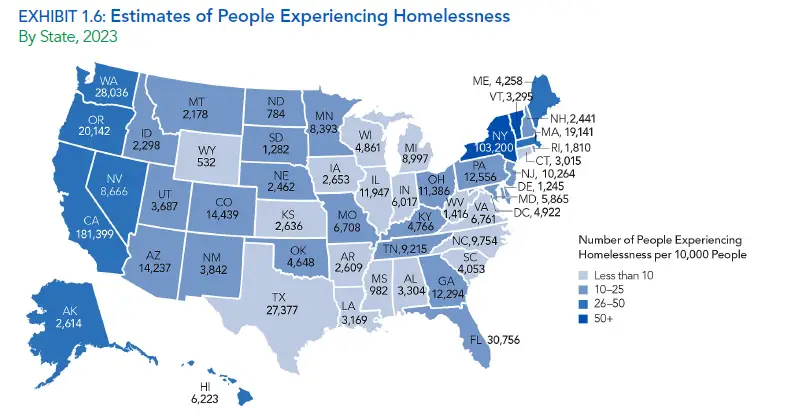
Source: Housing and Urban Development, U.S. Department. “The 2023 Annual Homelessness Assessment Report (AHAR) to Congress.” SSRN Electronic Journal, 2023, https://www.hud.gov/sites/dfiles/PA/documents/2023_PIT_Count_By_the_Numbers.pdf
Analysis
This detailed state-by-state analysis illustrates the diversity of strategies and challenges across the U.S. in addressing homelessness, highlighting tailored approaches based on local needs and resources.
Conclusion
While the challenge of homelessness is daunting, the diversity of approaches across the United States reflects a robust attempt to address the root causes and provide immediate relief to those in need. Continued focus on innovative solutions and partnerships remain key to making significant inroads against homelessness in all 50 states.
Insights and Trends
Across the states, several trends emerge:
- Housing Affordability: A common thread is the lack of affordable housing, prompting states to explore various funding and construction initiatives.
- Policy Approaches: From housing-first policies to emergency shelters and job training, states are adopting a mix of strategies tailored to their specific needs.
- Community Involvement: Successful mitigation often involves partnerships between state agencies, local nonprofits, and private sectors.
This detailed state-by-state analysis illustrates the diversity of strategies and challenges across the U.S. in addressing homelessness, highlighting tailored approaches based on local needs and resources.
Northeast
1. Maine (4,258 homeless): In Maine, rural homelessness is significant, often hidden in wooded camps or temporary shelters. The state has implemented housing-first programs to aid those in need.
2. New Hampshire (2,441 homeless): With its harsh winters, New Hampshire has focused on emergency winter shelters and permanent housing initiatives, especially in urban areas like Manchester.
3. Vermont (3,295 homeless): Vermont has a low population but a significant percentage of homeless individuals relative to its size, with state policies emphasizing preventive measures and supportive housing.
4. Massachusetts (19,141 homeless): Boston, in particular, has a wide range of programs targeting homelessness, including innovative housing lotteries and strong healthcare support for the homeless.
5. Rhode Island (1,810 homeless): Providence has seen successful efforts in reducing homelessness through strong state and community collaboration, including rapid rehousing strategies.
6. Connecticut (3,015 homeless): Connecticut’s focus is on combating homelessness with comprehensive mental health services and substantial investment in affordable housing projects.
7. New York (103,200 homeless): New York City notably struggles with a high homeless population, driven by high housing costs and income inequality. The state has extensive public shelter systems and active non-profit sectors working to provide relief.
8. New Jersey (10,264 homeless): High living costs drive homelessness in urban centers like Newark, with the state deploying significant resources in homeless prevention and rapid rehousing.
9. Pennsylvania (12,556 homeless): Economic shifts from manufacturing to service industries have left many without adequate wages, contributing to homelessness, particularly in cities like Philadelphia.
10. Delaware (1,245 homeless): Despite its small size, Delaware faces homelessness, particularly in Wilmington. The state’s response includes strong partnerships between government agencies and nonprofit organizations, focusing on both emergency shelters and long-term affordable housing initiatives.
Midwest
11. Ohio (11,386 homeless): Cleveland and other cities face homelessness issues with initiatives that focus on both temporary shelters and long-term sustainable housing.
12. Indiana (2,653 homeless): Indiana combats homelessness with extensive veteran-specific programs and preventative measures in schools to address youth homelessness.
13. Illinois (11,947 homeless): Chicago, with its significant homeless population, faces challenges related to mental health and affordable housing shortages. State and city programs focus on transitional housing and support services.
14. Michigan (8,997 homeless): Detroit’s economic downturns have dramatically affected homelessness, with initiatives focusing on redevelopment and affordable housing.
15. Wisconsin (4,861 homeless): Milwaukee’s programs include strong emphasis on mental health and addiction services, integrated with housing support.
16. Iowa (2,653 homeless): Des Moines utilizes a coordinated entry system to efficiently manage resources and direct support where it’s most needed.
17. Missouri (6,708 homeless): St. Louis and Kansas City have implemented aggressive outreach programs to connect homeless individuals with services and housing.
18. Nebraska (2,462 homeless): Focuses on rural homelessness with programs tailored to meet the unique challenges faced in less densely populated areas.
19. Kansas (2,636 homeless): Wichita leads with interventions aimed at families and children, preventing homelessness through education and support services.
20. Minnesota (8,393 homeless): Known for its cold winters, Minnesota has developed strong emergency shelter programs and long-term homelessness prevention strategies through state-wide collaborations.
21. South Dakota (1,282 homeless): With a significant Native American population, South Dakota integrates cultural competence into its homelessness strategies. Focuses on integrating social services to address both immediate and long-term needs of the homeless population.
22. North Dakota (784 homeless): The state addresses severe weather challenges and provides robust emergency shelter options.
South
23. Alabama (3,304 homeless): Birmingham and other cities see community-driven initiatives aimed at comprehensive support from healthcare to job training.
24. Mississippi (982 homeless): With high poverty rates, Mississippi emphasizes long-term economic solutions alongside immediate shelter provisions.
25. Louisiana (3,169 homeless): New Orleans has developed substantial post-hurricane strategies to deal with displacement and homelessness.
26. Arkansas (2,609 homeless): Little Rock’s strategy includes a strong emphasis on partnerships between state agencies and faith-based organizations.
27. Kentucky (4,766 homeless): Lexington and Louisville focus on youth homelessness, with programs that provide both education and housing stability.
28. Tennessee (9,215 homeless): Nashville has made significant strides with “housing first” initiatives that prioritize getting people into housing before addressing other issues.
29. West Virginia (1,416 homeless): The state addresses homelessness with a focus on the opioid crisis and its impact on housing stability.
30. Virginia (6,761 homeless): Richmond has seen success with integrated services that connect homelessness prevention directly to community healthcare and education systems.
31. North Carolina (9,754 homeless): Charlotte’s holistic approach focuses on substantial support systems including legal aid and health services.
32. South Carolina (4,053 homeless): Columbia and other cities combine efforts of various non-profits to provide a network of support for homeless individuals.
33. Georgia (12,294 homeless): Atlanta features numerous initiatives, including partnerships between the city government and private organizations to tackle homelessness through comprehensive community-based approaches.
34. Florida (30,756 homeless): With a high transient population, Florida faces unique challenges such as homelessness among seniors and veterans. The state has focused on outreach programs and federal funding assistance.
35. Texas (27,377 homeless): Urban centers like Houston and Dallas have large homeless populations. Texas has implemented successful localized programs that include rapid rehousing and job training.
West
36. Montana (2,178 homeless): Emphasizes community involvement and volunteer programs to assist homeless individuals in more isolated rural areas.
37. Wyoming (532 homeless): The state focuses on mobility programs to help homeless individuals access services that are spread out across this large and less densely populated state.
38. Idaho (2,298 homeless): Boise addresses homelessness with a focus on both urban and rural needs, facilitating access to services across diverse communities.
39. Washington (28,036): Seattle faces significant challenges with homelessness, exacerbated by high living costs. Local governments and organizations work together on innovative housing solutions and support services.
40. Oregon (20,142 homeless): Portland’s challenges are met with aggressive public funding and innovative policies such as sanctioned camping areas and comprehensive outreach programs.
41. California (181,399 homeless): With the largest homeless population in the U.S., California’s major cities struggle with visible street homelessness. The state has invested billions in homelessness prevention and affordable housing.
42. Nevada (8,666): Las Vegas experiences high rates of homelessness due to a large transient population and service-oriented economy. Efforts include strong crisis intervention and behavioral health services.
43. Utah (3,687 homeless): Salt Lake City has been recognized for its efforts to reduce chronic homelessness through a robust housing-first approach and effective use of data to drive policy.
44. Arizona (14,237 homeless): Phoenix combines heat relief initiatives with long-term housing strategies due to the extreme temperatures affecting the homeless population.
45. Colorado (14,439 homeless): Denver utilizes a mix of technology and public-private partnerships to manage and prevent homelessness effectively.
46. New Mexico (3,842 homeless): Albuquerque utilizes a strong network of community services to address homelessness amid high levels of poverty.
47. Alaska (2,614 homeless): Faces unique challenges due to geographic isolation and extreme weather, focusing on specialized services tailored to indigenous populations and remote areas.
48. Hawaii (6,223 homeless): Honolulu deals with high tourism impact and limited land, focusing on innovative solutions like converting temporary tourist accommodations into permanent housing.
49. Oklahoma (4,648 homeless): Oklahoma City focuses on recovery from economic downturns with substantial investment in mental health services integrated with homeless prevention.
50. New Mexico (3,842 homeless): Albuquerque utilizes a strong network of community services to address homelessness amid high levels of poverty.


